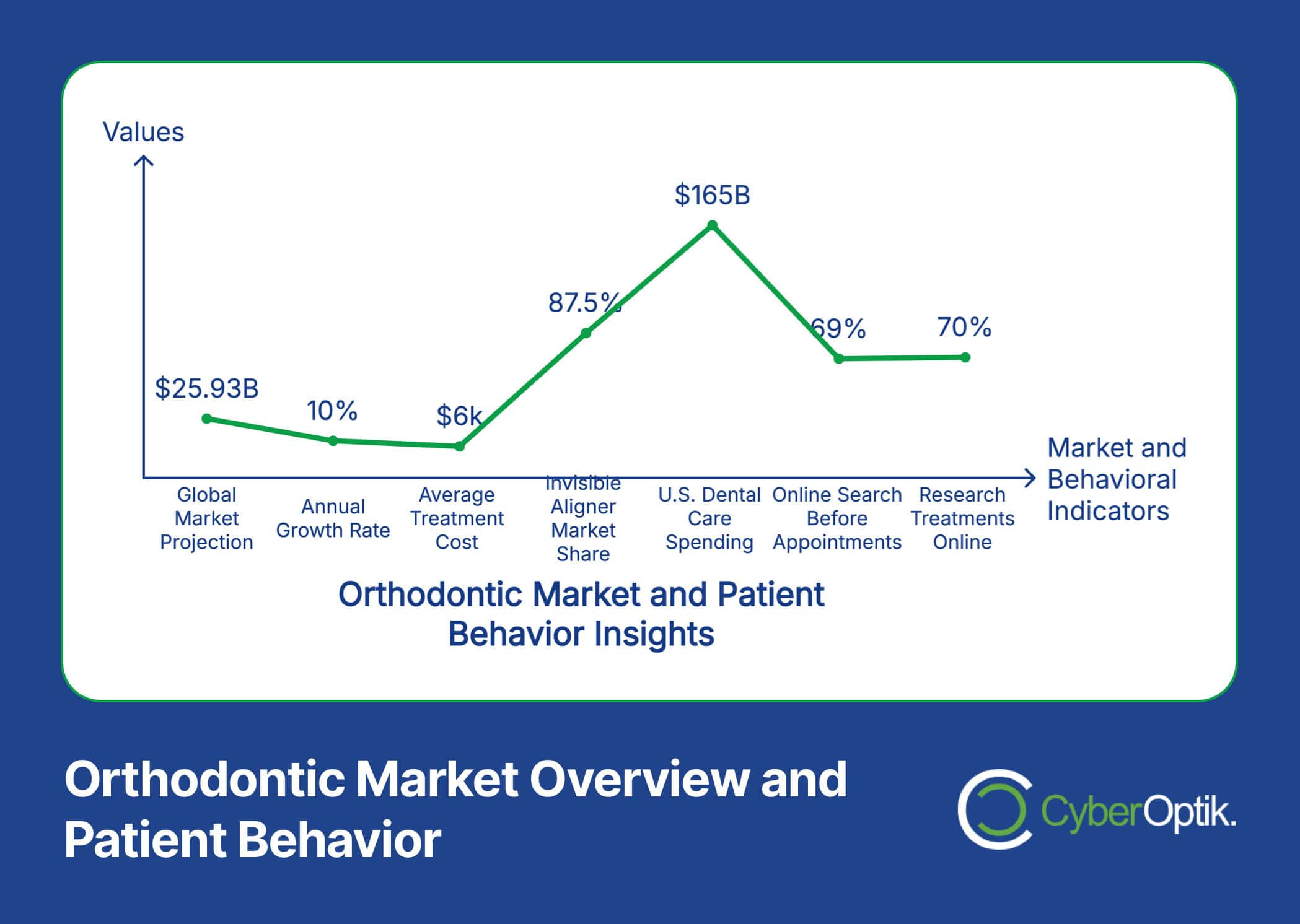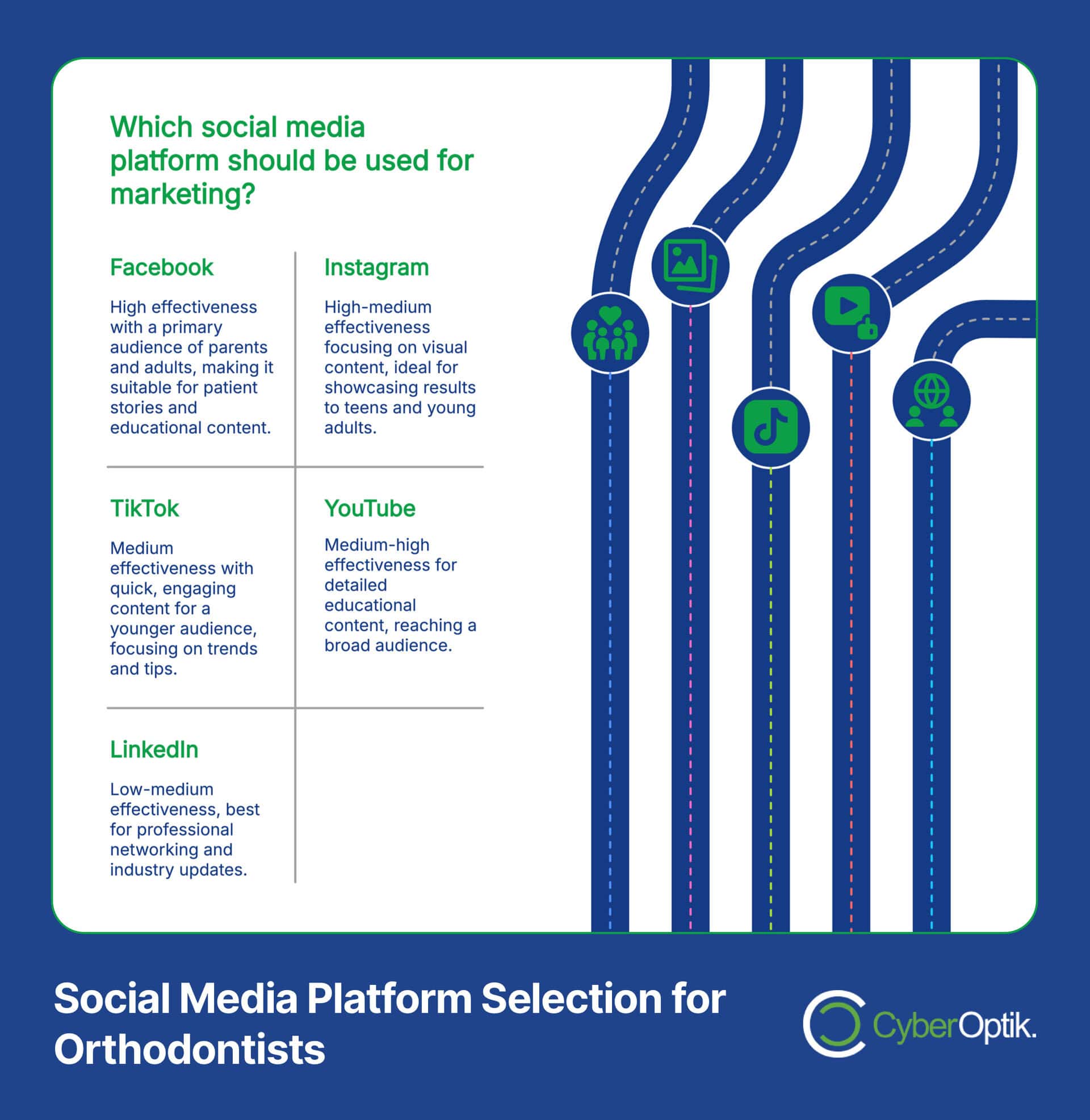Orthodontic marketing has evolved significantly in recent years. Digital channels now play a crucial role in patient acquisition for practices of all sizes. Today’s orthodontic patients research extensively before making decisions about their care providers.
When potential patients consider orthodontic treatment, their journey typically begins online. In fact, 69% of patients search online before booking orthodontic appointments. (Source: Ortho Marketing)
For orthodontic practices, this digital-first approach creates both challenges and opportunities. The right marketing strategy can dramatically increase patient flow and practice revenue. Poorly executed marketing, however, wastes valuable resources and fails to connect with ideal patients.
As a web design and development agency that works with healthcare providers, we understand the unique marketing needs of orthodontic practices. This comprehensive guide explores the most effective strategies to attract new patients and grow your orthodontic practice in today’s competitive landscape.
Understanding the Orthodontic Marketing Industry
The orthodontic industry continues to grow and evolve. Market forces and patient behaviors shape marketing effectiveness. Understanding these trends helps practices create more targeted strategies.
Current Market Trends in Orthodontics
The global orthodontics market shows strong growth potential. Industry projections indicate significant expansion in the coming years. This growth creates both opportunity and competition for practices.

Let’s examine the current market landscape to provide context for our marketing strategies:
| Metric | Value | Source |
|---|---|---|
| Global Market Projection (2032) | $25.93 billion | The Brainy Insights |
| Annual Growth Rate (CAGR) | 10% | The Brainy Insights |
| Invisible Aligner Market Share | 87.5% | 2740 Consulting |
| Average Treatment Cost | $6,000 per patient | Direction Inc |
| U.S. Dental Care Spending (2022) | $165 billion | Ortho Marketing |
The orthodontic market is projected to reach $25.93 billion by 2032, growing at a 10% compound annual growth rate. (Source: The Brainy Insights) This robust growth indicates substantial opportunity for practices with effective marketing.
One significant trend is the dominance of invisible aligners, which now hold 87.5% of the market share. (Source: 2740 Consulting) This shift toward less visible treatment options highlights changing patient preferences that should inform your marketing approach.
Despite these positive indicators, practices face challenges. Recent data shows that average orthodontist production declined 4.7% in 2023. (Source: Orthodontic Products Online) This decline makes effective marketing even more crucial for maintaining practice growth.
Digital Behavior of Orthodontic Patients
Understanding how potential patients search for and evaluate orthodontic services is essential. Their digital behaviors directly impact which marketing channels will be most effective.
Research shows clear patterns in how patients approach orthodontic decisions:
- 70% of consumers research dental treatments online before making decisions. (Source: Ortho Marketing)
- Both parents and adult patients typically visit 4-5 websites before contacting a practice
- Most potential patients read reviews as part of their decision process
- Mobile devices account for over half of all orthodontic website visits
- Video content significantly increases engagement with younger demographics
Americans spent $165 billion on dental care in 2022, showing the significant market size for dental services including orthodontics. (Source: Ortho Marketing) With average orthodontic treatments costing around $6,000 per patient, the revenue potential for practices that effectively market their services is substantial. (Source: Direction Inc)
These patterns show why digital marketing has become essential for orthodontic practices. Patients no longer simply accept referrals without research. They actively evaluate providers online before making contact.
Essential Website Strategies for Orthodontic Practices
Your website serves as the digital foundation of your orthodontic practice. It often creates the first impression for potential patients. A well-designed website converts visitors into consultation requests and ultimately into patients.
Website Design Elements That Convert Patients
Effective orthodontic websites share certain characteristics that enhance conversion rates. These elements create trust and make it easy for potential patients to take action.
The following table highlights the most impactful website elements for orthodontic practices:
| Website Feature | Impact on Conversions | Implementation Notes |
|---|---|---|
| Before/After Gallery | High | Include diverse cases and treatment types |
| Secure Contact Forms | 40% increase | Require minimal information initially |
| Patient Testimonials | Medium-High | Include photos and specific outcomes |
| Treatment Cost Information | Medium | Include financing and insurance details |
| Doctor Credentials | Medium | Highlight education, experience, and awards |
Research confirms that websites optimized with these elements generate 2-3 times more inquiries than basic informational sites. (Source: Direction Inc) The right combination of these features creates a patient-centered experience that builds trust and encourages action.
When designing your orthodontic website, prioritize clarity and simplicity. Patients should easily understand your services, locate your contact information, and find answers to their most common questions. Complex navigation or cluttered pages create friction that reduces conversion rates.
We recommend including prominent calls-to-action throughout your site. These might include “Schedule a Free Consultation,” “Get a Virtual Assessment,” or “Download Our Patient Guide.” Each page should guide visitors toward taking the next step in becoming a patient.
Mobile Optimization for Orthodontic Websites
Mobile optimization is no longer optional for orthodontic practices. Google’s mobile-first indexing means your site’s mobile version determines your search rankings. More importantly, patients increasingly research and contact orthodontists via smartphones.
Effective responsive design ensures your website functions properly across all devices. This includes:
- Quick loading times (under 3 seconds)
- Easy touch navigation
- Readable text without zooming
- Properly sized buttons and form fields
- Clickable phone numbers for immediate calling
Data shows that mobile-friendly websites with secure forms boost conversions by 40% for orthodontic practices. (Source: Direction Inc) This significant improvement comes from creating a seamless experience that aligns with how patients actually use their devices.
Beyond basic responsiveness, consider implementing mobile-specific features. Click-to-call buttons, mobile appointment booking, and location-based directions enhance the mobile user experience for orthodontic patients.
Conversion Rate Optimization Techniques
Conversion rate optimization (CRO) focuses on increasing the percentage of website visitors who take desired actions. For orthodontic practices, these actions typically include scheduling consultations, requesting information, or contacting the office.
Effective CRO for orthodontic websites involves several key strategies:
- Strategic form placement – Position consultation request forms prominently on high-traffic pages
- Simplified scheduling – Reduce the steps required to book an appointment
- Social proof integration – Display reviews and testimonials near call-to-action buttons
- Value proposition clarity – Clearly communicate what makes your practice unique
- Trust indicators – Include credentials, affiliations, and security badges
Testing different approaches is essential for optimization. Simple A/B tests on elements like button colors, form layouts, or headline phrasing can significantly impact conversion rates. Regular analysis helps identify which changes produce the best results.
Remember that conversion optimization is an ongoing process. Patient preferences evolve, and website performance should be continuously monitored and improved to maintain optimal results.
Search Engine Optimization for Orthodontists
When potential patients search for orthodontic services, your practice needs to appear prominently in search results. Search engine optimization (SEO) increases your visibility to these high-intent prospects.
The financial impact of effective SEO for orthodontists is substantial. A monthly SEO investment of $3,000-$4,000 typically generates between $270,000 and $540,000 in revenue within six months. (Source: Direction Inc) This impressive return comes from consistently attracting patients who are actively searching for orthodontic services.
Local SEO Strategies for Orthodontic Practices
Since orthodontic practices serve specific geographic areas, local SEO typically generates the highest return on investment. These strategies help your practice appear in location-based searches like “orthodontist near me” or “braces in [your city].”
Essential local SEO elements for orthodontists include:
- Optimized Google Business Profile with complete information
- Consistent NAP (Name, Address, Phone) across all online directories
- Location-based keywords in website content
- Location pages for each office location
- Local backlinks from community organizations
Google Business Profile optimization deserves special attention. This free tool significantly impacts local search visibility. Ensure your profile includes accurate business category (Orthodontist), complete contact information and hours, recent photos of your office and team, responses to all patient questions, and regular posts about services and promotions.
Local citation building also strengthens your practice’s visibility. Being listed accurately on dental directories, local business sites, and insurance provider portals reinforces your location relevance to search engines.
Content Marketing That Attracts Orthodontic Patients
Content marketing establishes your expertise while providing valuable information to potential patients. Well-executed content strategies increase website traffic, improve search rankings, and build trust with prospective patients.
Research indicates that orthodontic practices with blogs and educational videos increase consultation bookings by 40%. (Source: Direction Inc) This significant improvement highlights how valuable content can attract patients who are researching treatment options.
Effective content topics for orthodontic websites include treatment comparisons (traditional braces vs. clear aligners), patient concerns addressed (pain, treatment duration, eating restrictions), cost and insurance information, before and after case studies, and age-specific information (orthodontics for children, teens, adults).
Content should address the questions potential patients are asking. Use tools like Google’s “People Also Ask” feature to identify common questions related to orthodontic treatments. Creating content that directly answers these questions increases your chances of appearing in featured snippets.
Remember to optimize all content for relevant keywords without sacrificing readability. Natural language that truly helps patients will perform better than keyword-stuffed content that sounds artificial.
Technical SEO for Dental Websites
Technical SEO ensures search engines can properly access, crawl, and index your orthodontic website. While less visible than content, these technical elements significantly impact your search rankings.
Key technical SEO elements for orthodontic websites include page speed optimization, mobile optimization, secure website (HTTPS), structured data markup, and XML sitemap. Each of these technical factors plays a crucial role in your site’s search performance.
Page speed deserves particular attention for orthodontic websites. Slow-loading pages cause potential patients to abandon your site before converting. Tools like Google PageSpeed Insights can identify specific improvements for your website.
Structured data (schema markup) helps search engines understand the content on your orthodontic website. Implementing LocalBusiness, MedicalBusiness, and FAQ schema can improve how your practice appears in search results.
A well-executed SEO strategy drives 20-30 new patients per month after six months, potentially yielding $720,000-$1.08 million annually for an orthodontic practice. (Source: Direction Inc) This substantial return makes SEO one of the most valuable marketing investments for orthodontists.
Social Media Marketing for Orthodontists
Social media platforms offer powerful ways to connect with potential patients, showcase your work, and build your practice’s brand. A strategic social media presence helps orthodontists reach both parents and patients directly.

Platform Selection and Strategy
Not all social media platforms deliver equal value for orthodontic practices. Research shows that 76% of orthodontists and 89% of patients/parents use social media, with Facebook being the most preferred platform for both groups. (Source: PMC) This data helps practices focus their efforts on the most relevant channels.
The following table compares key social platforms for orthodontic marketing:
| Platform | Primary Audience | Best Content Types | Effectiveness |
|---|---|---|---|
| Parents, Adults 25-65 | Patient stories, office updates, educational content | High | |
| Teens, Young Adults 15-35 | Before/after photos, staff highlights, office culture | High-Medium | |
| TikTok | Teens, Young Adults 13-24 | Quick tips, behind-the-scenes, trending challenges | Medium (age-dependent) |
| YouTube | All Ages | Educational videos, treatment explanations, testimonials | Medium-High |
| Professional Referrals | Industry updates, continuing education, practice milestones | Low-Medium (B2B focus) |
Rather than trying to maintain a presence on every platform, orthodontic practices should focus on 2-3 channels that best align with their target patient demographics. This focused approach allows for higher quality content and more consistent engagement.
Your social media strategy should consider both your practice’s strengths and your resource availability. Visually-oriented practices might excel on Instagram or TikTok, while those with strong educational content might perform better on YouTube or Facebook.
Content Ideas That Drive Engagement
Effective social media content for orthodontists balances educational value with entertainment and brand building. The content should reflect your practice’s personality while providing useful information to potential patients.
Engaging content ideas for orthodontic social media include before and after transformations, staff spotlights, patient celebrations, treatment explanations, patient testimonials, and office events and community involvement. Each of these content types serves different objectives in your overall marketing strategy.
Consistency is key for social media success. Establish a regular posting schedule that your team can maintain. Even a modest schedule of 2-3 quality posts per week will outperform sporadic bursts of activity followed by silence.
User-generated content can be particularly valuable for orthodontic practices. Encourage patients to share their experiences and transformation photos (with appropriate permissions). This authentic content often generates higher engagement than professionally produced posts.
Paid Social Media Advertising for Patient Acquisition
While organic social media builds your brand over time, paid social advertising can drive immediate results. Strategic ad campaigns allow orthodontic practices to reach specific demographic and geographic targets.
Facebook and Instagram ads offer particularly strong targeting options for orthodontists. You can create campaigns targeting parents in specific age ranges within your service area, users who have shown interest in dental or orthodontic content, people within certain income brackets likely to afford treatment, and lookalike audiences based on your current patient demographics.
When creating orthodontic social media ads, focus on clear value propositions. Highlight special offers, financing options, or unique treatment approaches. Include strong calls-to-action that direct potential patients to landing pages designed for conversion.
Video content typically outperforms static images in orthodontic social ads. Short videos showing treatment results, explaining procedures, or featuring patient testimonials tend to generate higher engagement and conversion rates.
Testing multiple ad variations helps identify the most effective messaging and creative approaches. Start with modest budgets spread across several ad concepts, then allocate more resources to the best performers.
Reputation Management and Patient Reviews
Online reputation management has become essential for orthodontic practices. Patient reviews significantly influence potential patients’ provider choices. A strategic approach to generating and managing reviews provides a substantial competitive advantage.
Building a Strong Online Reputation
Your online reputation reflects how patients perceive your practice. Building a positive reputation requires both delivering excellent care and actively managing your digital presence.
Practices with 50+ Google reviews attract 2.5 times more patients than those with fewer reviews. (Source: Direction Inc) This dramatic difference highlights the impact of reviews on both patient decisions and search visibility.
A comprehensive reputation management strategy includes monitoring all review platforms, responding promptly to all reviews, analyzing feedback patterns, showcasing positive reviews, and addressing negative reviews constructively. Each component plays an important role in maintaining a strong online presence.
Remember that potential patients often read the most recent reviews first. Maintaining a steady stream of fresh positive reviews keeps your reputation current and relevant.
Strategies for Generating Positive Patient Reviews
Consistently generating authentic patient reviews requires a systematic approach. How can you encourage satisfied patients to share their experiences without being pushy or violating platform policies?
Effective review generation strategies include:
- Asking for reviews at key satisfaction moments (like braces removal)
- Creating simple review request cards with QR codes
- Training staff to naturally mention reviews during positive interactions
- Following up consultations with review requests via email or text
- Using automated review management platforms to streamline requests
Timing is crucial when requesting reviews. The ideal moment is when patients are experiencing positive emotions about their treatment results. For orthodontic practices, this often occurs during milestone appointments, especially braces removal or treatment completion.
Make the review process as simple as possible. Direct links to your Google Business Profile or other review platforms eliminate friction. Consider creating both printed materials with QR codes and digital options via email or text message.
Automated tools can help systematize your review request process. These platforms send timely follow-ups after appointments and track which patients have already been asked for feedback. This systematic approach consistently produces more reviews than ad hoc requests.
Handling Negative Reviews Effectively
Even excellent practices occasionally receive negative reviews. How you respond to criticism can actually enhance your reputation if handled properly.
When responding to negative reviews, respond promptly (within 24-48 hours), remain professional, acknowledge concerns, take the conversation offline by providing contact information for direct resolution, and offer solutions when appropriate. Each of these steps helps demonstrate your commitment to patient satisfaction.
Remember that your response to a negative review has two audiences: the dissatisfied patient and all future potential patients who will read the exchange. A thoughtful, professional response demonstrates your practice’s commitment to patient satisfaction.
In some cases, after resolving issues offline, you can politely ask if the patient would consider updating their review. Many patients are willing to modify negative reviews once their concerns have been addressed satisfactorily.
Referral Marketing for Orthodontic Practices
Referrals remain a powerful source of new patients for orthodontic practices. Both professional referrals from dentists and patient-to-patient referrals can significantly boost your practice growth.
Creating Effective Referral Programs
Structured referral programs consistently outperform informal “word-of-mouth” approaches. These programs incentivize current patients to refer friends and family while making the process simple and rewarding.
Automated referral tools and systems improve patient retention by approximately 15%. (Source: Direction Inc) This improvement comes from creating stronger connections with your patient community and providing tangible benefits for loyalty.
Effective orthodontic referral programs typically include clear incentives, simple mechanics, multiple referral paths, recognition elements, and staff involvement. The most successful programs integrate these elements into a cohesive system that makes referring others both rewarding and simple.
Common incentives for orthodontic referral programs include account credits, gift cards, practice-branded merchandise, or entries into periodic prize drawings. The specific incentives should align with your practice positioning and patient demographics.
Digital tools can streamline referral tracking and reward fulfillment. These systems automatically attribute new patients to their referral source and track the resulting practice growth. This data helps refine your referral program over time.
Building Relationships with Dentists and Other Providers
Professional referrals from dentists and other healthcare providers represent a significant patient acquisition channel. Research shows that 38% of new orthodontic patients come from dentist referrals. (Source: Orthodontic Products Online) This substantial percentage makes dental relationships a top priority.
Effective strategies for strengthening professional referral relationships include:
- Regular lunch-and-learn sessions with referring practices
- Consistent communication about shared patients
- Offering CE courses for local dental professionals
- Creating referral-friendly materials for dental offices
- Expressing appreciation through thoughtful gestures
Communication consistency matters for professional referrals. Provide regular updates on shared patients’ treatment progress. Create systems that make this communication efficient rather than time-consuming.
Educational content can strengthen referral relationships. Offering useful information about when to refer patients for orthodontic evaluation benefits both the dental practice and potential patients. This positioning as an educational resource enhances your value as a referral partner.
Remember that professional referral relationships are built on trust and mutual benefit. Focus on how your orthodontic services complement and enhance the referring dentist’s patient care rather than simply seeking their referrals.
Patient Incentive Strategies
Strategic incentives can motivate both new patient acquisition and treatment acceptance. These offers address common barriers to beginning orthodontic treatment.
Effective incentive approaches for orthodontic practices include new patient specials (discounted initial consultations or exams), financing options (interest-free payment plans), seasonal promotions (limited-time offers tied to school schedules), family discounts (reduced rates for multiple family members), and treatment upgrades (premium options included with standard packages).
When creating incentives, consider both the appeal to potential patients and the financial impact on your practice. Focus on offers that drive high-value patient acquisition without significantly reducing profitability.
Incentives should be promoted across all marketing channels. Include them on your website, social media, email campaigns, and in-office materials. Consistent messaging about available offers increases their effectiveness in attracting new patients.
Track which incentives generate the highest quality patients rather than just the highest volume. Some offers may attract more price-sensitive patients, while others may appeal to those seeking premium treatment options. This data helps refine your incentive strategy over time.
Measuring Marketing Success for Orthodontists
Effective marketing measurement allows orthodontic practices to focus resources on strategies that deliver results. Data-driven decisions maximize return on marketing investment while eliminating wasteful spending.
Key Performance Indicators to Track
Measuring the right metrics ensures you understand your marketing performance. Different KPIs provide insights into various aspects of your marketing funnel.
The following table outlines essential marketing metrics for orthodontic practices:
| Metric Category | Specific KPIs | Measurement Frequency |
|---|---|---|
| Website Performance | Visitors, Bounce Rate, Conversion Rate | Weekly |
| Lead Generation | New Contacts, Form Submissions, Calls | Weekly |
| Patient Acquisition | Consultations, Treatment Starts, Case Acceptance Rate | Monthly |
| Marketing ROI | Cost Per Lead, Cost Per Start, Marketing-Attributed Revenue | Monthly |
| Patient Retention | Retention Rate, Referral Rate, Review Rate | Quarterly |
Attribution tracking helps identify which marketing channels generate the most valuable patients. Implementing proper tracking allows you to connect new patients to their original marketing source, whether SEO, social media, referrals, or paid advertising.
When analyzing metrics, focus on trends rather than isolated data points. Month-over-month and year-over-year comparisons reveal meaningful patterns that help refine your marketing strategy over time.
Remember that different metrics matter at different practice stages. Growing practices might prioritize new patient acquisition, while established practices might focus more on treatment acceptance rates and patient retention.
Tools for Marketing Analytics
The right analytics tools simplify data collection and provide actionable insights. These platforms help orthodontic practices understand their marketing performance without requiring advanced technical skills.
Essential analytics tools for orthodontic practices include Google Analytics (tracks website performance), call tracking software (attributes phone calls to marketing sources), CRM systems (connects marketing to patient acquisition), social media analytics (measures engagement), and review management platforms (tracks reputation metrics).
Google Analytics 4 provides comprehensive website performance data. Configure it to track important conversion events like appointment requests, contact form submissions, and phone calls. This data reveals which website content drives patient inquiries.
Call tracking solutions assign unique phone numbers to different marketing channels. This technology allows you to attribute phone inquiries to specific sources like Google Ads, social media, or directory listings. The resulting data helps optimize your marketing mix.
Practice management or CRM systems connect marketing activities to actual patient starts. This closed-loop reporting shows not just which channels generate inquiries, but which ones produce the highest quality patients who accept treatment recommendations.
Adjusting Strategies Based on Data
Data-driven marketing adjustments maximize your return on investment. Regular analysis allows orthodontic practices to double down on effective strategies while modifying or eliminating underperforming tactics.
The adjustment process should follow these steps: regular data review (establish a consistent schedule), pattern identification (look for performance trends), hypothesis development (create theories about what’s working), strategic adjustments (modify your approach based on data), and results monitoring (track the impact of changes).
Be willing to reallocate resources based on performance data. If certain channels consistently deliver better results, consider shifting budget and attention toward those high-performing areas. This ongoing optimization process continuously improves your marketing effectiveness.
Remember that both positive and negative data provide valuable insights. Underperforming campaigns often reveal important information about patient preferences or messaging effectiveness that can improve future marketing efforts.
Creating an Integrated Orthodontic Marketing Strategy
Effective orthodontic marketing requires an integrated approach that combines multiple strategies. These complementary tactics work together to attract, engage, and convert potential patients.
The most successful orthodontic practices implement comprehensive marketing systems rather than isolated tactics. Their strategies encompass the entire patient journey from initial awareness through treatment completion and referrals.
Begin by prioritizing the foundations: a conversion-optimized website, strong local SEO, and systematic review generation. These elements provide the infrastructure for all other marketing efforts. Then layer in social media, content marketing, and paid advertising to expand your reach and visibility.
Remember that consistency matters more than perfection. Regular, ongoing marketing activities consistently outperform sporadic, intensive campaigns. Create sustainable systems your team can maintain over time rather than unsustainable bursts of activity.
As digital marketing continues to evolve, stay informed about new opportunities while maintaining focus on proven strategies. The core principles of providing value, building relationships, and clearly communicating benefits remain constant even as specific platforms and tactics change.
By implementing these comprehensive marketing strategies, your orthodontic practice can attract more qualified patients, improve treatment acceptance rates, and achieve sustainable growth in today’s competitive landscape.




